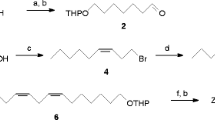Abstract
Extracts from different body parts of adult femaleEriocrania cicatricella (Zett.) were tested for electrophysiological activity on conspecific male antennae. Extracts from the Vth abdominal segment, containing a pair of exocrine glands, elicited the largest electroantennographic response when compared to extracts of other body parts. Female extracts were analyzed by gas chromatography with simultaneous flame ionization and electroantennographic detection (EAD). The EAD active peaks were identified as (Z)-4-hepten-2-one, (2R)-heptane-2-ol, and (2R)-(Z)-4-hepten-2-ol by coinjection on a gas chromatography and by comparison of mass spectra with those of synthetic standards. In field tests, a blend of these three pheromone components was highly attractive to conspecific males, and a subtractive assay confirmed that the unsaturated alcohol is the major pheromone component, whereas no definite behavioral activity could be assigned to the ketone or the saturated alcohol. A bait containing the two alcohols withS-configuration was attractive to maleE. sparrmannella (Bosc), whereas no males ofE. cicatricella were found in these traps. The sex pheromone compounds inE. cicatricella are chemically similar to pheromones reported in Trichoptera and they are produced in homologous glands.
Similar content being viewed by others
References
Anderbrant, O., Löfqvist, J., Jönsson, J., andMarling, E. 1989. Effects of pheromone trap type, position and colour on the catch of the pine sawflyNeodiprion sertifer (Geoff.) (Hym., Diprionidae),J. Appl. Entomol. 107:365–369.
Arn, H., Tóth, M., andPriesner, E. 1992. List of sex pheromones of Lepidoptera and related attractants. OILB-SROP Publ., Paris.
Brown, C.A., andAhuja, V.K. 1973. “P-2 nickel” catalyst with ethylenediamine, a novel system for highly stereospecific reduction of alkynes.J. Chem. Soc. Chem. Commun. 1973:553–555.
Davis, D.R. 1975. Systematics and zoogeography of the family Neopseustidae with the proposal of a new superfamily (Lepidoptera, Neopseustoidea),Smithson. Contrib. Zool. 210:1–45.
Davis, D.R. 1978. A revision of the North American moths of the superfamily Eriocranioidea with the proposal of a new family Acanthopteroctetidae (Lepidoptera).Smithson. Contrib. Zool. 251:1–231.
Gaylord, N.G., andBecker, E.I. 1951. The reaction between Grignard reagents and the oxirane ring.Chem. Rev. 49:413–533.
Herscovici, J., Egron, M.-J., andAntonakis, K. 1982. New oxidative systems for alcohols: Molecular sieves with chromium-(VI)-reagents.J. Chem. Soc. Perkin Trans. 1967–1973.
Huwyler, S. 1973. Ultramikromethoden: Katalytische Hydrierung.Experientia 29:1310–1311.
Jacobson, R., Taylor, R.J., Williams, H.J., andSmith, L.R. 1982. Naturally occurring spirocyclic ketals from lactones.J. Org. Chem. 47:3140–3142.
Kozlov, M.V. 1985. Precopulatory behaviour of primitive moths (Lepidoptera).Entomol. Obozr. 64:493–505.
Kozlov, M.V. 1988. Biology ofEriocrania sparrmannella Bosc. (Lepidoptera, Eriocraniidae).Vestn. Zool. (Kiev) 4:80–85.
Kristensen, N.P. 1984a. The pregenital abdomen of the Zeugloptera (Lepidoptera).Steenstrupia 10:113–136.
Kristensen, N.P. 1984b. Studies on the morphology and systematics of Primitive Lepidoptera.Steenstrupia 10:141–191.
Löfstedt, C. 1991. Evolution of moth pheromone, pp. 57–73,in I. Hrdy (ed.). Insect Chemical Ecology. Proceedings of a Conference held in Tábor 1990. Academia Prague and SPB Acad. Publ., The Hague, The Netherlands.
Löfstedt, C., Hansson, B.S., Petersson, E., Valeur, P., andRichards, A. 1994. Pheromonal secretions from glands on the Vth abdominal sternite of hydropsychid and rhyacophilid caddisflies (Trichoptera).J. Chem. Ecol. 20:153–170.
McLafferty, F.W., andStauffer, D.B. 1989. The Wiley/NBS Registry of Mass Spectral Data. J. Wiley & Sons, New York.
Nielsen, A. 1980. A comparative study of the genital segments and the genital chamber in female Trichoptera.Biol. Skr. 23:1–200.
Noirot, C.E., andQuennedy, A. 1974. Fine structure of insect epidermal glands.Annu. Rev. Entomol. 19:61–80.
Percy-Cunningham, J.E. andMacDonald, J.A. 1987. Biology and ultrastructure of sex pheromone-producing glands, pp. 27–76,in G.D. Prestwich and G.J. Blomquist (eds). Pheromone Biochemistry. Academic Press, New York.
Pirngruber, 1944. Blütenökologische Untersuchungen über einige Falter der GattungMicropteryx.Verhandl. Zool. Ges. Wien. 90/91:129–220.
Razowski, J. 1975. Abdominal scent organs in Homoneura (Lepidoptera).Pol. Pismo Entomol. 45:3–7.
Szöcs, G., Tóth, M., Francke, W., Schmidt, F., Philipp, P., König, W.A., Mori, K., Hansson, B.S., andLöfstedt, C. 1993. Species discrimination in five species of winter-flying geometrids (Lepidoptera) based on the chirality of semiochemicals and flight season.J. Chem. Ecol. 19:2721–2735.
Tóth, M., Szöcs, G., J. van Nieukerken, E., Philipp, P., Schmidt, F., andFrancke, W. 1995. Novel type of sex pheromone structure identified fromStigmella malella (Stainton) Lepidoptera: Nepticulidae).J. Chem. Ecol. 21:13–27.
Wagner, D.L., andRosovsky, J. 1991. Mating systems in primitive Lepidoptera, with emphasis on the reproductive behaviour ofKorscheltellus gracilis (Hepialidae).Zool. J. Linn. Soc. 102:277–303.
Wood, J.R. andResh, H.V. 1984. Demonstration of sex pheromones in caddisflies (Trichoptera).J. Chem. Ecol. 10:171–175.
Author information
Authors and Affiliations
Rights and permissions
About this article
Cite this article
Zhu, J., Kozlov, M.V., Philipp, P. et al. Identification of a novel moth sex pheromone inEriocrania cicatricella (Zett.) (Lepidoptera: Eriocraniidae) and its phylogenetic implications. J Chem Ecol 21, 29–43 (1995). https://doi.org/10.1007/BF02033660
Received:
Accepted:
Issue Date:
DOI: https://doi.org/10.1007/BF02033660




